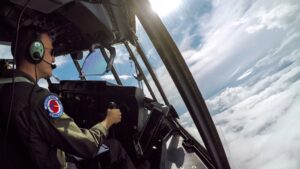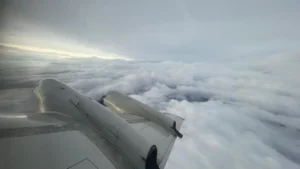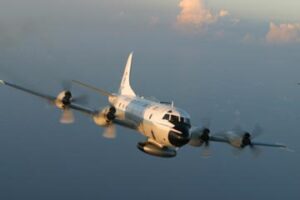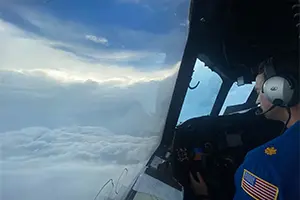After bouncing back from firings, a flight engineer says the team is ready for any challenge.
By Ramon Lopez
Original Air Date: June 4, 2025
Host: The 2025 storm season officially began last weekend, and our reporter Ramon Lopez caught up with hurricane hunters. They talked about more than the weather—the DOGE chainsaw also reached NOAA, the federal agency that tracks hurricanes.
[Engines whir loudly]
Crew member: Well! [chuckle] Gotta keep these pockets zipped.
Ramon Lopez: That’s the sound crew members hear when they fly into the world’s worst weather and into the eye of horrific hurricanes on National Oceanic Atmospheric Administration Hurricane Hunter aircraft.
A Hurricane Hunter describes a typical mission.

Pilot at the controls of a NOAA HH plane. Photo by 1st Lt. Ryan Smithies, NOAA Corps.
Hurricane Hunter: We’re measuring sea surface temperature, how wet the eye is, what the humidity is, how much heat is coming out of that eye—basically everything that atmosphere is doing. What we’re looking for is that geographical center of the low pressure. Once we find that, that’s where we can really tell what that storm is doing and what it might do next.
RL: NOAA’s two Lockheed Martin WP-3D Orion four-engine turboprop aircraft, affectionately nicknamed Kermit and Miss Piggy, probe every wind and pressure change during the course of a typical eight-to-ten hour mission.
The high-flying weather stations supply much of the data local weathermen use to make accurate forecasts during a hurricane.

A NOAA WP-3D Orion N43RF, known as Miss Piggy, flies into Tropical Storm Idalia in August 2023 as it formed into a major hurricane. Photo via NOAA.
The P-3s are based at Lakeland Linder International Airport in Lakeland, Florida.
WSLR News recently got a chance to speak to NOAA’s Daniel Tyson. The Hurricane Hunter flight engineer attended a hurricane expo in Venice, sharing what he does to keep people informed and safe once a hurricane has developed.
The four-year Hurricane Hunter came to NOAA from the U.S. Navy where he spent eleven years as a flight engineer on similar P-3 Orion anti-submarine warfare patrol aircraft.
Daniel Tyson: We’re trained in the navy or the military as a flight engineer. There’s not many people in thew world that can do exactly what we do that are so diverse in the aircraft, so our reputation kind-of precedes us at this point. When I got out of the Navy, I got a phone call from a couple pilot buddies at NOAA, and they got me to come fly with them.
A flight engineer is responsible for the aircraft. Any normal and emergencies that could occur with the aircraft. We’re there from starting the engines to shutting them down the entire time, making sure and monitoring the engines.

A Lockheed WP-3D Orion.
RL: Becoming a NOAA Hurricane Hunter was a life-long dream for Tyson.
DT: I had always seen the Hurricane Hunters on the news and thought that was an awesome experience—awesome job—awesome pride and professionalism that they exuberate. I just wanted to be a part of that culture.
RL: Hurricane Hunter aircraft are buffeted by howling winds, blinding rain and violent updrafts and downdrafts before entering the relative calm of a hurricane’s eye.
DT: It feels like you’re on the roughest wooden roller coaster that’s just going through a car wash.
There’s always a level of fear, but it’s always overcome by, job duty satisfaction. You have a job. You need to do it. You kind-of pocket that fear.
RL: There are only six flight engineers on staff plus navigators and 20 to 25 pilots and copilots flying the two Hurricane Hunters.
There’s also a flight director on board, according to Tyson.

A NOAA Corps pilot flies a WP-3D Orion N43RF Hurricane Hunter to measure atmospheric conditions during Hurricane Ida. Photo by Lt. Cmdr. Kevin Doremus, NOAA Corps.
DT: The flight director is by far the most important position on the plane. The flight director is the on-board meteorologist that is making sure that we get into the storm safely and get out of the storm safely. They’re extremely important. Flight directors have a very tough path to NOAA. In fact, it’s kind-of the pinnacle of their careers. Most meteorologists work to get to this spot, and it’s a bunch of grueling tests and proving themselves in the meteorology world. It’s pretty difficult to become a flight director.
RL: NOAA only has seven flight directors, but only five are flight qualified. This past February, The Trump administration laid off two flight directors. But they were brought back a month later.
DT: They were brought back due to how strenuous that job is. It’s not something that anyone could fill. Mission-critical.
We were ecstatic because we’re already extremely understaffed as it is. We’ve constantly been trying to hire more flight directors—more flight engineers—because we need the manning, and to lose any part of our personnel was is devastating, even if it is a small number. Everyone’s highly trained, highly skilled, in what they do.
RL: Tyson says the Hurricane Hunters are ready to handle any missions that come their way this hurricane season.
DT: With what we have now, we are able to fully man the flight schedule. Any task that we get thrown at us, we’ll be able to handle it. We’re just ready to complete any task on our way, sir. I’m so excited to wake up and head to work to do this mission.
RL: This is Ramon Lopez for WSLR News.
WSLR News aims to keep the local community informed with our 1/2 hour local news show, quarterly newspaper and social media feeds. The local news broadcast airs on Wednesdays and Fridays at 6pm.